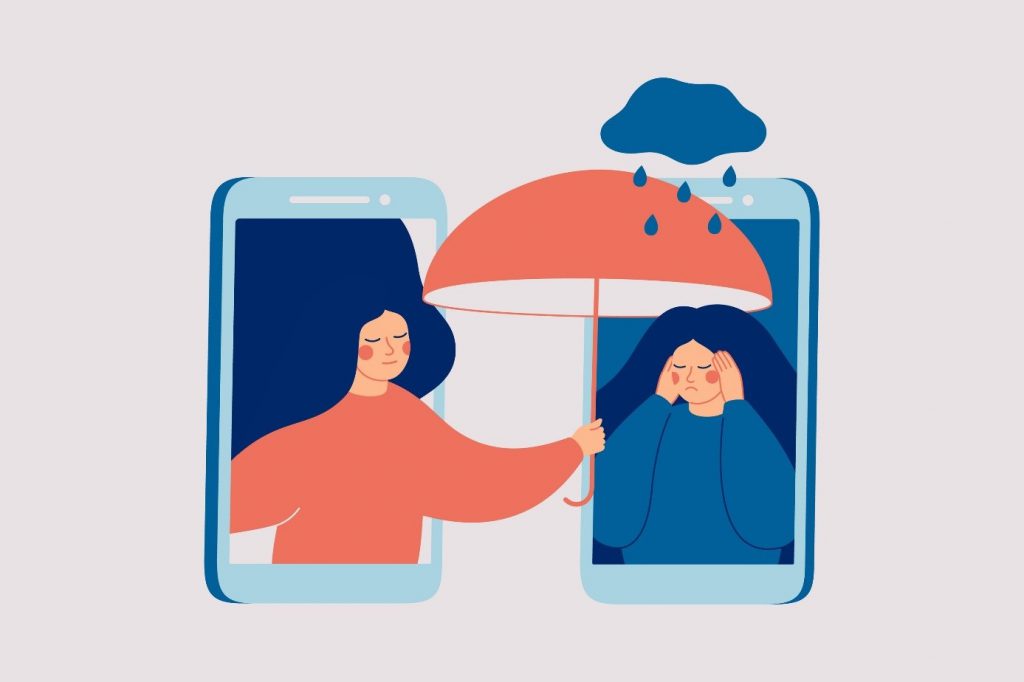Adolescents and social media: a social safety net in a fragile phase of development

The current generation of adolescents has to stay at home with parents most of the time and follow online lessons instead of going to school. They are forced to stay physically distant from peers during a period of life in which they crave friends and social interactions the most. Fortunately, teens today have the chance to turn to technology to stay socially connected. Why are teens in particular suffering from the radical change in social environment? And what solutions does the use of social media offer?
From a biological perspective, turning to digital social spaces makes sense. Especially in the absence of social interactions elsewhere. Adolescents (between 10 and 24 years) go through a uniquely sensitive phase of development in which almost every activity is focused on fitting in. Changes in the brain and the hormonal system shape the process of breaking free from primary caregivers and form the strong desire to feel accepted and belong to peer groups. In the past decennia, neuroscientists have been discovering that the typical adolescent brain is actually equipped to process social experiences as extremely valuable. By comparing the brains of adolescents with those of children and adults, we measure that being judged by peers is eliciting a stronger reaction in teens. When adolescents just look at pictures of facial expressions in a lab setting, their brains get more active.
Researchers have been keeping track of the growth of neural connections between specific brain areas while teenagers get older. What they find: brain areas that are involved in social behaviour grow relatively fast in comparison to other parts of the brain. This specific pattern of brain development highly influences adolescents’ behaviour and goals: they naturally become more motivated to engage in social activities with peers.
The natural urge to spend time with peers is much needed at a young age. Socially orienting yourself independent from parents trains you to be an autonomous social adult. On the downside however, feeling lonely or socially isolated during this formative period of life is shown to be uniquely damaging for the development of structures in the brain. It may even trigger psychological problems and depression. Being active on social media may help teens to overcome a sense of social isolation.
Scholars from various research disciplines emphasise that social media is indeed fitting in adolescents’ developmental processes. The routine of chatting, updating, and sharing via social media platforms gives the levers to manage self-presentation, learning to express oneself and to develop one’s own identity. Researchers that measure brain activity patterns even show us that teens experience the social stimuli hosted by social media as evenly gratifying as when they engage in offline interaction.
Digital spaces can be a lifesaver on a much broader scale. LGBTQ youths for instance, who often lack confidence to express themselves in their physical surroundings or struggle to belong, turn to safe spaces on the internet. When I was exploring my sexual orientation as a teenager, social media was my biggest support. The LGBTQ-corner of the internet encouraged me to eliminate doubts and allowed me to feel more comfortable about my sexuality in online and offline surroundings.
Over the last decades, the online world as well as safe spaces for LGBTQ identifying youths have been expanding drastically. LGBTQ teens today take to the video-sharing app TikTok to share feelings and struggles or to seek for recognition in content uploaded by others. On such a platform, they can encounter like-minded peers whom they may not easily find in their physical environment. While there is still a lack of positively reflected queer representation in the mainstream media, various social media platforms offer a place for self-discovery, social connection and support.
Although the impact of enforced physical distancing may not be completely comparable with the struggles that marginalized groups of youths might face, it does show what the online social environment is capable of. Social media has the potential to stretch a safety net below teenagers in a formative period of social development. Digital spaces provide a crucial tool to connect and support each other while physically distant or when lacking a sense of normality elsewhere.
At the same time, however, some concerned voices claim that constantly being online might be rather unfavourable for teenagers well-being. Considering the average of six to seven hours spend on digital devices on a weekday (reported by Dutch adolescents during corona times), these concerns are not at all surprising. Even adolescents themselves are questioning whether they spend too much time behind their screens. Among Dutch adolescents, 60% report to feel uncomfortable with the number of hours they are online.
The concerns seem legitimate. The extend to which technology can assist in adolescents’ social development has its boundaries. Socializing with a screen in between is essentially different from its real-life counterpart, resulting in inevitable negative consequences on the flip side of the coin. Photo-sharing platforms such as Instagram entail an uncanny great emphasis on quantifiability of social endorsement. Many teens suffer from the pressure to portray an unrealistic self-image on their online profiles, or to achieve social standards that may be displayed on social media.
Of course, text-based communicating contains less social cues and an asynchrony of interaction. This might make social experiences in the online world challenging and less fulfilling. Algorithms continue to ensure you mainly encounter what you already like, imposing anyone who uses social media with the limitations of engaging in your online social bubble. Face-to-face social interactions with peers and the spontaneity of socializing in physic social events or in school surroundings are still necessities.
It is, on the one hand, more important than ever to focus psychological and brain research on the opportunities of the online world to assist in youths’ social development. On the other hand, although youths experience positive social support in many online settings, we still need more research into the limitations of social media’s role in the development of teens. We need experimental studies to find out to what extend social media is sufficient to fulfil adolescents’ social needs. How should we approach social media to support a healthy and responsible social environment? For both adolescents during physical distancing, but also for adolescents who already find less connection in their offline surroundings, these questions are of vital importance.
Contact
Erasmus University Rotterdam
Mandeville Building T13
Burgemeester Oudlaan 50
3062 PA Rotterdam, the Netherlands

